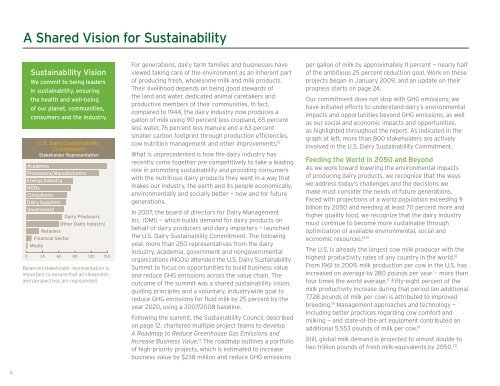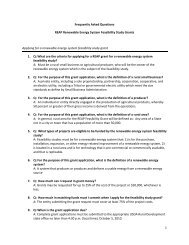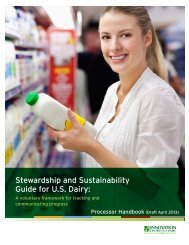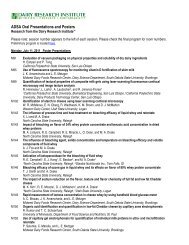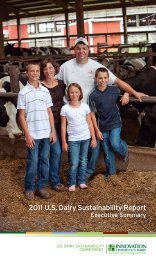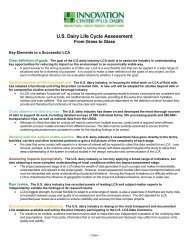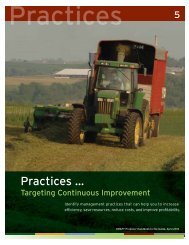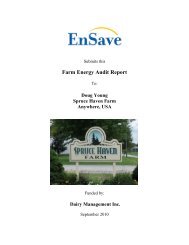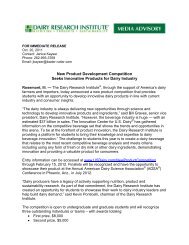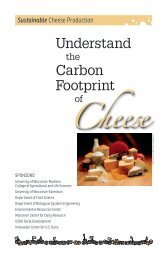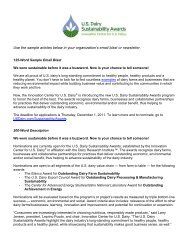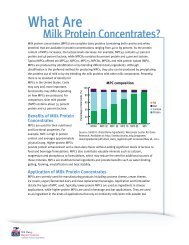2011 U.S. Dairy Sustainability Report - Innovation Center for US Dairy
2011 U.S. Dairy Sustainability Report - Innovation Center for US Dairy
2011 U.S. Dairy Sustainability Report - Innovation Center for US Dairy
You also want an ePaper? Increase the reach of your titles
YUMPU automatically turns print PDFs into web optimized ePapers that Google loves.
A Shared Vision <strong>for</strong> <strong>Sustainability</strong><br />
<strong>Sustainability</strong> Vision<br />
We commit to being leaders<br />
in sustainability, ensuring<br />
the health and well-being<br />
of our planet, communities,<br />
consumers and the industry.<br />
U.S. <strong>Dairy</strong> <strong>Sustainability</strong><br />
Commitment<br />
Stakeholder Representation<br />
Academia<br />
Processors/Manufacturers<br />
Energy Industry<br />
NGOs<br />
Consultants<br />
<strong>Dairy</strong> Suppliers<br />
Government<br />
Retailers<br />
Financial Sector<br />
Media<br />
<strong>Dairy</strong> Producers<br />
Other <strong>Dairy</strong> Industry<br />
0 30 60 90 120 150<br />
Balanced stakeholder representation is<br />
important to ensure that all viewpoints<br />
and perspectives are represented.<br />
For generations, dairy farm families and businesses have<br />
viewed taking care of the environment as an inherent part<br />
of producing fresh, wholesome milk and milk products.<br />
Their livelihood depends on being good stewards of<br />
the land and water, dedicated animal caretakers and<br />
productive members of their communities. In fact,<br />
compared to 1944, the dairy industry now produces a<br />
gallon of milk using 90 percent less cropland, 65 percent<br />
less water, 76 percent less manure and a 63 percent<br />
smaller carbon footprint through production efficiencies,<br />
cow nutrition management and other improvements. 12<br />
What is unprecedented is how the dairy industry has<br />
recently come together pre-competitively to take a leading<br />
role in promoting sustainability and providing consumers<br />
with the nutritious dairy products they want in a way that<br />
makes our industry, the earth and its people economically,<br />
environmentally and socially better — now and <strong>for</strong> future<br />
generations.<br />
In 2007, the board of directors <strong>for</strong> <strong>Dairy</strong> Management<br />
Inc. (DMI) — which builds demand <strong>for</strong> dairy products on<br />
behalf of dairy producers and dairy importers — launched<br />
the U.S. <strong>Dairy</strong> <strong>Sustainability</strong> Commitment. The following<br />
year, more than 250 representatives from the dairy<br />
industry, academia, government and nongovernmental<br />
organizations (NGOs) attended the U.S. <strong>Dairy</strong> <strong>Sustainability</strong><br />
Summit to focus on opportunities to build business value<br />
and reduce GHG emissions across the value chain. The<br />
outcome of the summit was a shared sustainability vision,<br />
guiding principles and a voluntary, industrywide goal to<br />
reduce GHG emissions <strong>for</strong> fluid milk by 25 percent by the<br />
year 2020, using a 2007/2008 baseline.<br />
Following the summit, the <strong>Sustainability</strong> Council, described<br />
on page 12, chartered multiple project teams to develop<br />
A Roadmap to Reduce Greenhouse Gas Emissions and<br />
Increase Business Value. 13 The roadmap outlines a portfolio<br />
of high-priority projects, which is estimated to increase<br />
business value by $238 million and reduce GHG emissions<br />
per gallon of milk by approximately 11 percent — nearly half<br />
of the ambitious 25 percent reduction goal. Work on these<br />
projects began in January 2009, and an update on their<br />
progress starts on page 24.<br />
Our commitment does not stop with GHG emissions; we<br />
have initiated ef<strong>for</strong>ts to understand dairy’s environmental<br />
impacts and opportunities beyond GHG emissions, as well<br />
as our social and economic impacts and opportunities,<br />
as highlighted throughout the report. As indicated in the<br />
graph at left, more than 800 stakeholders are actively<br />
involved in the U.S. <strong>Dairy</strong> <strong>Sustainability</strong> Commitment.<br />
Feeding the World in 2050 and Beyond<br />
As we work toward lowering the environmental impacts<br />
of producing dairy products, we recognize that the ways<br />
we address today’s challenges and the decisions we<br />
make must consider the needs of future generations.<br />
Faced with projections of a world population exceeding 9<br />
billion by 2050 and needing at least 70 percent more and<br />
higher quality food, we recognize that the dairy industry<br />
must continue to become more sustainable through<br />
optimization of available environmental, social and<br />
economic resources. 14,15<br />
The U.S. is already the largest cow milk producer with the<br />
highest productivity rates of any country in the world. 16<br />
From 1961 to 2009, milk production per cow in the U.S. has<br />
increased on average by 280 pounds per year — more than<br />
four times the world average. 17 Fifty-eight percent of the<br />
milk productivity increase during that period (an additional<br />
7,728 pounds of milk per cow) is attributed to improved<br />
breeding. 18 Management approaches and technology —<br />
including better practices regarding cow com<strong>for</strong>t and<br />
milking — and state-of-the-art equipment contributed an<br />
additional 5,553 pounds of milk per cow. 19<br />
Still, global milk demand is projected to almost double to<br />
two trillion pounds of fresh milk equivalents by 2050. 20<br />
6


